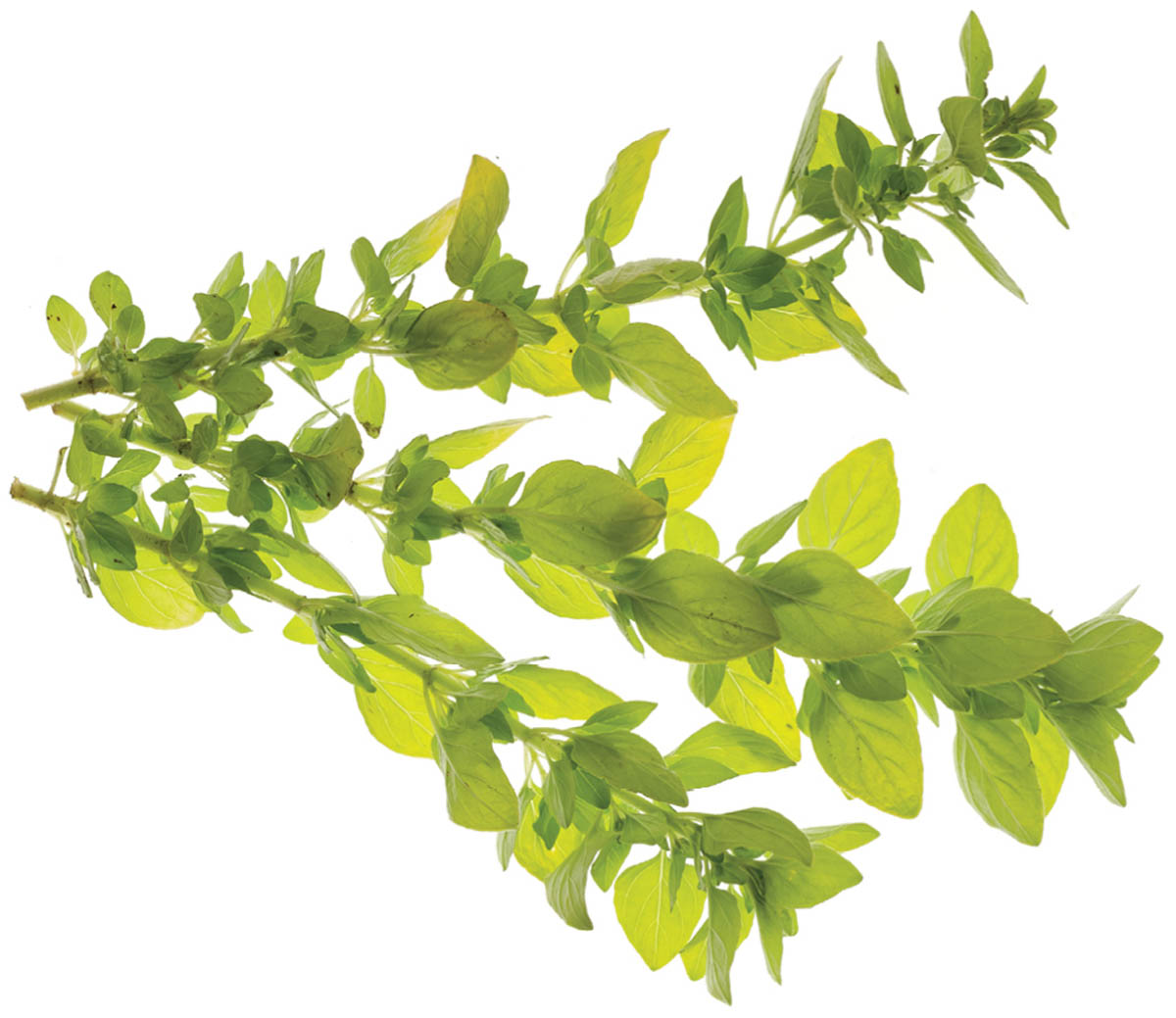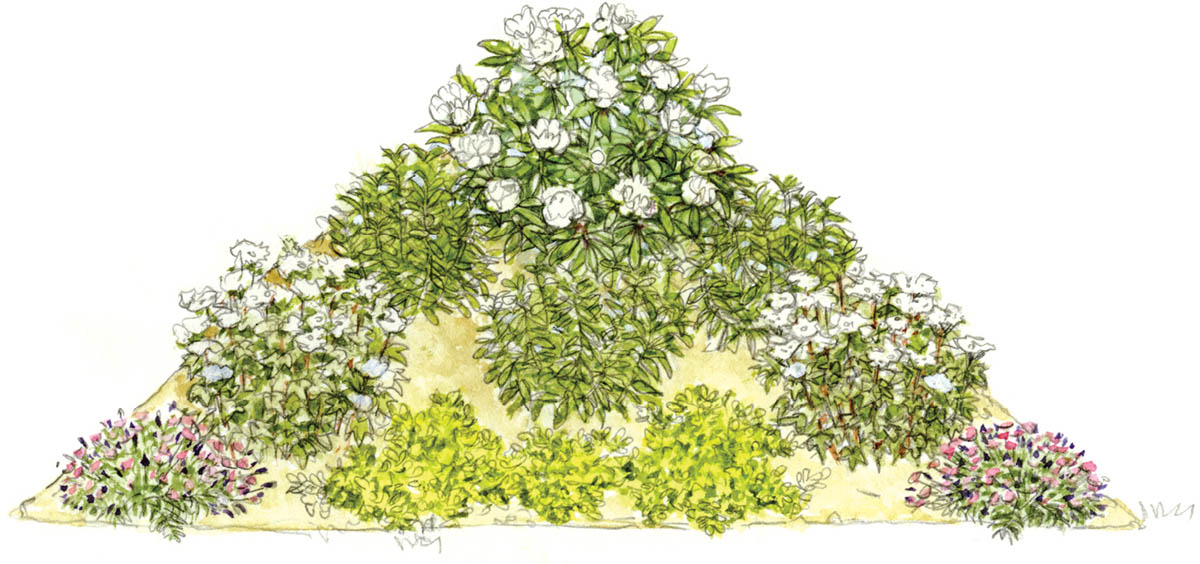Fabulous Fragrance
Full sun to partial shade
Average soil

This garden is a delight to more than the eyes; it’s a treat for your sense of scent as well. Perennials with fragrant flowers are a wonderful choice for plantings along a path or walkway, where you can get up close to enjoy the perfumed blooms. They’re also lovely outside of a window, where the fragrance can drift indoors in summer, or near a porch, patio, deck, or other outdoor sitting area.
The Garden Plan
Shopping List
1 ‘Festiva Maxima’ peony
Paeonia
1 plant
Zones 3–8
Alternates: Another fragrant peony or other 2- to 5-foot-tall perennial with scented flowers or leaves, such as a hyssop (Agastache) [1 plant] or ‘Silk Road’ or another Orienpet lily [3 bulbs]

‘Festiva Maxima’ peony (Paeonia)
2 Variegated meadowsweet
Filipendula ulmaria ‘Variegata’
2 plants
Zones 3–9
Alternates: Another 2- to 4-foot-tall perennial with scented flowers or leaves, such as variegated sweet iris (Iris pallida ‘Variegata’) [6 plants] or a bee balm (Monarda) [2 plants]

Variegated meadowsweet (Filipendula ulmaria ‘Variegata’)
3 ‘David’ phlox
Phlox paniculata
3 plants
Zones 4–9
Alternates: Another 3- to 4-foot-tall perennial with scented flowers or leaves, such as ‘Ice Ballet’ swamp milkweed (Asclepias incarnata) [3 plants] or ‘White Swan’ purple coneflower (Echinacea purpurea) [3 plants]

‘David’ phlox (Phlox paniculata)
4 Cheddar pink
Dianthus gratianopolitanus
2 plants
Zones 3–8
Alternates: Another fragrant dianthus or other 6- to 12-inch-tall perennial with scented flowers or leaves, such as wall rock cress (Arabis caucasica) [2 plants] or calamint (Calamintha nepeta) [2 plants]

Cheddar pink (Dianthus gratianopolitanus)
5 Golden oregano
Origanum vulgare ‘Aureum’
3 plants
Zones 4–8
Alternates: Another 9- to 18-inch-tall perennial with scented flowers or leaves, such as ‘Berggarten’ sage (Salvia officinalis) [3 plants] or variegated lemon thyme (Thymus × citriodorus ‘Aureus’) [5 plants]

Golden oregano (Origanum vulgare ‘Aureum’)
Planting Plan


Season by Season
Spring: The peony and cheddar pink generally start sharing their scents in late spring. ‘Festiva Maxima’ peony produces bushy clumps of rich green, glossy leaves topped with large, fully double white flowers, while the cheddar pink creates carpets of slender, blue-gray leaves that are covered with an abundance of single pink blooms. The phlox’s bright green foliage isn’t especially interesting now, but the variegated meadowsweet’s yellow-splashed, deep green leaves are quite eye-catching, and the golden oregano contributes bright yellow leaves that release their rich, spicy scent when you rub or brush against them.
In early to mid spring, cut down any dead or winter-damaged top growth, and divide any of the perennials that were starting to outgrow their space by the end of the previous year. The peony’s flowers can be very heavy and tend to flop, so you may want to place a hoop-type or grid-type support over the emerging shoots in spring so they’ll be supported as they grow. Finish up by spreading a fresh layer of organic mulch over the soil to get the garden off to a great start for the growing season.
Summer: ‘Festiva Maxima’ peony finishes flowering in early summer, if not before, but the cheddar pink usually reaches its peak bloom then. (It takes a break in midsummer but may send up some more flowers in late summer.) Early to midsummer also brings on the variegated meadowsweet, with its plume-like clusters of creamy white blooms over leaves that are now solid green. It often overlaps with the mid- to late-summer bloom season of ‘David’ phlox, which produces domed clusters of bright white flowers. Golden oregano blooms, too, with tiny pinkish white blossoms, but it’s still the leaves that provide great scents to the garden.
Summer care for this garden is mostly a matter of removing the dead flowers to keep the plants looking neat, prevent them from producing unwanted seedlings, and possibly encourage the phlox and cheddar pink to rebloom. On the peony, snip off each spent bloom just above the uppermost leaf on the stem. On the variegated meadowsweet, cut off the finished flowering stalks near the base of the plant. On the phlox, clip off the entire flower cluster on each stem. And on the cheddar pink and golden oregano, trim off the finished flower stems individually or shear them off as a group just above the leaves. Water the garden during extended summer dry spells.
Fall and Winter: A bit of fragrance continues into fall, with some flowers possible on both the ‘David’ phlox and the cheddar pink. The golden oregano’s leaves continue to be aromatic through the fall and also last into winter.
If any of the perennials are crowding out their companions, you can divide them in early fall or wait until spring. Cut the peony, meadowsweet, and phlox stems to the ground in mid to late fall, but leave the rest of the cleanup until spring.
Digging Deeper
- A triangular plan like this is an obvious choice for fitting into a corner. Or, use it twice (flip the plan along one of the shorter sides to make one of the triangles a mirror image) and use the two parts to flank a short path leading to a cozy garden bench, where you and your guests can sit and enjoy the fragrance. If possible, site your scented garden in a place that’s sheltered from winds, because breezes tend to blow away some of the fragrance.
- Keep in mind that scents are very subjective: what smells wonderful to one person may be uninteresting or even unpleasant to someone else. Even among plants that most people enjoy, such as peonies (Paeonia), the type and strength of scent can vary quite a bit. So, if you want to enjoy your scented perennials to the fullest, try to shop for them when they are in bloom; that way, you can take a test smell before you buy.
- A planting of fragrant perennials already does double duty, adding beauty to your yard as well as wonderful scents to sniff. It doesn’t stop there, though, because fragrant flowers and leaves are also a joy to bring indoors for bouquets and arrangements. And if you incorporate aromatic herbs such as culinary sage (Salvia officinalis), oreganos (Origanum), winter savory (Satureja montana), lemon balm (Melissa officinalis), and lavenders (Lavandula), you can harvest them for use in cooking or crafts as well.